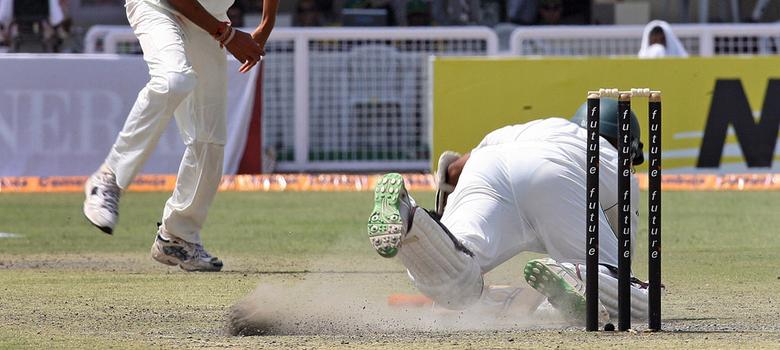
International cricket balks at the idea, reasonably pointing out that with cricket being the only sport to possess a symbiotic dependence on playing conditions, there is limitless variety on offer. A game between India and Australia can be played in damp British weather, on a searing Dubai summer day, or on a turning Nagpur dustbowl – with potentially three radically different results.
In 2009, the pitches manager of world cricket’s governing body explicitly ruled out standardising pitches. “The aim is to avoid pitches that produce standard conditions worldwide,” Andy Atkinson had said.
However, it does not mean that there is no standardisation in the game. The International Cricket Council has strict regulations about the dimensions of the playing surface. In addition, the Laws of Cricket lay down specifications for the bat and ball.
Yet, recent years have proved that this standardisation has not created a more equal game. Bats are noticeably bigger, but not heavier, and the boundaries are shorter. It is only of late that cricket’s governing body has woken up to this imbalance and has sought to rectify the problem.
A fairer game
Those who push for greater standardisation argue that it would make cricket a fairer game. Critics felt the spin-friendly Nagpur and Mohali surfaces were responsible for an unfair spectacle. Former cricketers Michael Hayden and Michael Vaughan said that the pitches were under-prepared. Similar remarks are made when the opposite happens – the pitches in the United Arab Emirates routinely come in for criticism for being a graveyard for bowlers.
So what is the solution? Hypothetically, one way would be to increase the mandate of the ICC Pitches Committee, which currently oversees the preparation of the surfaces used for major ICC events such as the Champions Trophy, the World Twenty20 and the World Cup. Some suggest that the Pitches Committee should be involved, on some level, in the preparation of any pitch that hosts international cricket.
While this would probably balance the competition between bat and ball, would it actually make for a better game? The jury is out, as cricket could well turn into a more streamlined entity.
ESPN Cricinfo’s David Hopps railed against the concept of standardisation of the game. “It is the variables in cricket that are a major part of its appeal,” he wrote. “Were that not so, we would have sought to improve the data by moving enthusiastically to artificial pitches, equipped batsmen with identical bats, and if funds could be found, roofed the stadiums so that Tests could be contested at a constant temperature, perhaps with a slight cross-breeze provided by a giant-sized A/C system.”
The practicalities also need to be considered. In the same interview of Andy Atkinson quoted earlier, the pitches manager was asked if match officials should arrive a week earlier to inspect a surface and recommend changes if unsatisfied. Atkinson agreed that the idea sounded good, but there were practical problems. For one, preparing pitches is a lengthy process and changing the venue of a match in a week was not a feasible solution. Secondly, individual boards of countries would not take too kindly to the perceived interference.
Too many variables
Perhaps the matter could be resolved by simply laying down a minimum set of regulations. But even that would be difficult as preparing a pitch is not an exact science. Unlike football fields or tennis courts, the rules cannot be set in stone – a curator has to consider various external factors like the nature of the soil, the nature of grass, the overhead conditions, humidity of the venue – all of which differ from region to region.
Which brings us back to the system already in place. There will always be potential for misuse if individual cricket boards are entrusted with the responsibility of preparing the playing conditions – obviously, every cricket board’s first priority would be to ensure its team’s success. The solution perhaps does not lie in standardising conditions, but in ensuring that such misuse invites strict punishment.
If the International Cricket Council is serious about fair playing conditions, it must start considering a wide range of penalties for individual cricket boards that prepare unsporting surfaces.
More than commercial fines, the ICC could consider the much harsher step of stripping a match of its result if the host is deemed to have overstepped the boundaries of fairness. While this would be a hugely bold step, it would first require all major cricketing nations to come to some sort of consensus on the exact nature of a “fair” playing surface.
